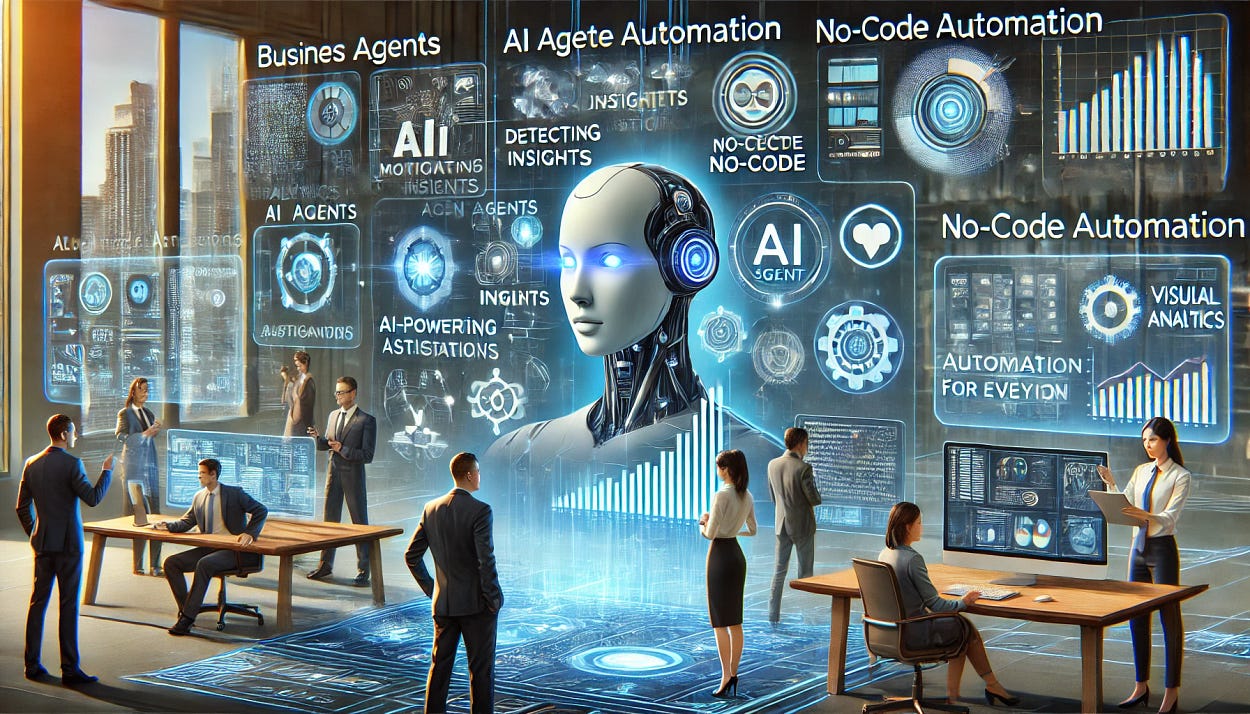AI Agents and No-Code Automation: Analytics for Everyone (Tomorrow)
Driving the Analytics of 2030, not 2020

The future of analytics isn’t just about better dashboards or faster reports — it’s about rethinking how we harness data to drive competitive advantage. In my full article, Driving the Analytics of 2030, Not 2020, I explored how organizations need to shift their mindset and strategy to keep pace with the evolving analytics landscape. This section walk through The Evolution of Analytics Execution, uncovering key insights and practical strategies for forward-thinking data leaders.
Democratizing analytics is not just about analysis tools, but also about making data action-oriented. We touched on no-code automation in operations; here let’s emphasize how **Agentic AI (**the technology that powers AI agents so they can act autonomously without human oversight) and no-code tools will help spread analytics everywhere by 2030.
AI Agents for Data
Think of small AI programs that can perform specific analytics tasks or decision-making support autonomously. For example, an AI agent monitors social media for brand mentions and sentiment. Another monitors your supply chain for disruptions (e.g., news of a natural disaster near a supplier) and automatically alerts the procurement team with potential impact analysis. These are not full human-level AIs, but focused agents embedded in business processes. By 2030, many routine analytical tasks (monitoring, detecting, alerting, minor decision rules) will be offloaded to such agents. It’s like each department gets a team of tireless AI interns. The key is they’re embedded — you don’t have to run a report; the agent just watches and acts. For instance, a marketing AI agent could auto-adjust Google ad bids based on performance data streaming in, within limits you set — essentially automating analytics-driven decisions at micro-scale continuously.
No-Code Platforms (Democratizing Data Tech)
We’ve mentioned platforms like n8n, FlowFuse and make.com. These allow users to build automated workflows and even data pipelines with visual interfaces. By 2030, these will be commonplace, and likely much smarter. Users might create a workflow like: “Every day, take data from System A, combine it with System B, run this analysis, and send an alert if threshold X is crossed” — all without writing code. This is powerful because it decentralizes the creation of analytics solutions. A sales ops person frustrated with manual weekly reports can self-serve an automation that not only generates the report but emails the insights to the team. The data engineering bottleneck (IT building every data pipeline) could be alleviated by no-code solutions governed properly. Opendatasoft’s research noted that the world is accelerating towards a no-code, data-driven future, where anyone can create data apps or visualizations. We see this already with citizen data scientists building apps on tools like Power Platform or Airtable with minimal coding.
Read more: [How no-code solutions aid data democratization — Opendatasoft](https://www.opendatasoft.com/en/blog/how-no-code-solutions-aid-data-democratization/#:~:text=Gaining true value from data,driven future)
GenAI for Code and Content
Generative AI will also help even when code is needed. By 2030, if you do need a Python script for a custom analysis, you might just tell an AI assistant what you want and it’ll generate the code (we’re already close to that with GitHub Copilot, etc.). Similarly for presentations — AI can write a narrative of insights and even design visualizations. So the “last mile” of analytics (turning analysis into a story or a decision) gets easier. Gartner predicted that by 2025, data stories will be the most widespread way to consume analytics, and 75% of these stories will be automatically generated by AI (a stat floating around industry talks). That means rather than poring over raw charts, executives might get a nicely written one-page story every morning: “Yesterday, sales dipped 3%. The likely cause was lower website traffic due to a Facebook outage. Don’t worry, traffic is back today. Here’s a highlight of product lines that still exceeded targets…”. Such narrative analytics can make insights digestible and actionable, and AI is uniquely suited to produce them at scale.
All these developments serve one goal: making analytics ubiquitous and easy. When every employee can harness data as naturally as they use email, a truly data-driven culture emerges. In fact, one of the biggest challenges is not the tech, but the people, which brings us to the importance of culture and leadership in this journey.
The path to 2030’s analytics landscape isn’t about incremental improvements — it requires bold rethinking and strategic transformation. In the next article, we’ll dive into Building a Data-Driven Culture.